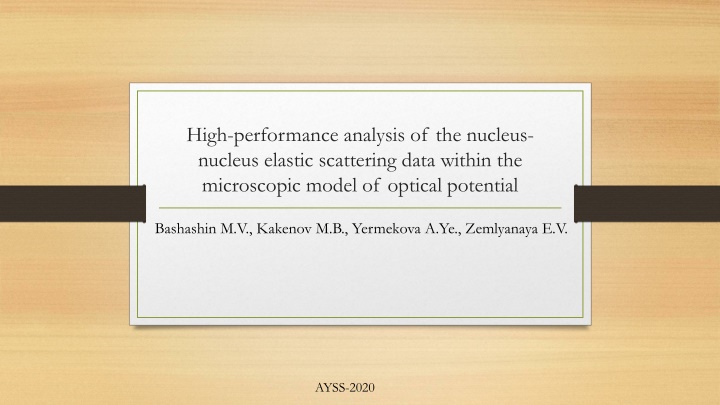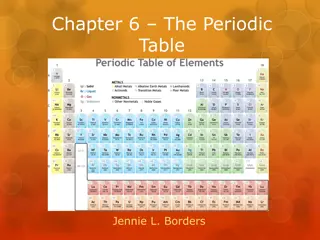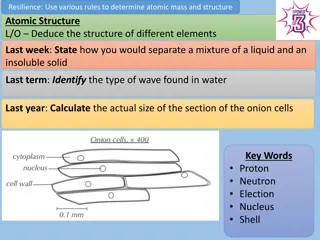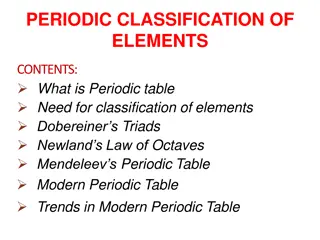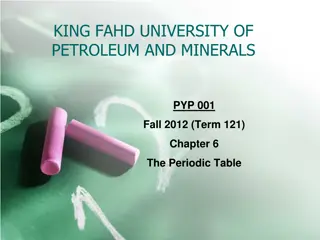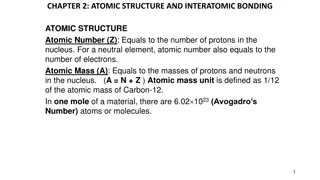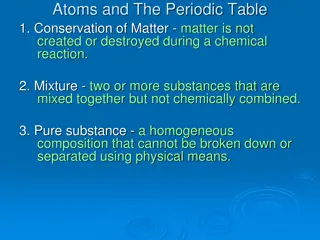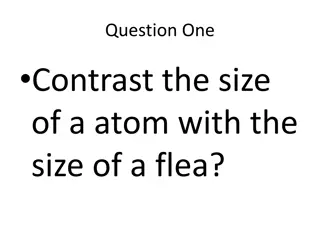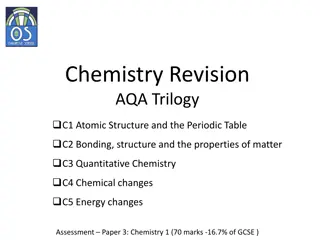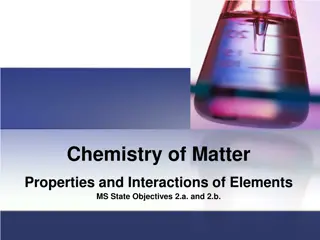Particle Nature of Matter: Atomic Structure & Periodic Table
Building on the atomic structure of matter and the periodic table of elements, this content delves into the properties and classification of matter, exploring physical and chemical characteristics along with the kinetic theory of matter. It emphasizes the importance of understanding the fundamental units of matter to comprehend the complexities of chemistry.
Download Presentation

Please find below an Image/Link to download the presentation.
The content on the website is provided AS IS for your information and personal use only. It may not be sold, licensed, or shared on other websites without obtaining consent from the author.If you encounter any issues during the download, it is possible that the publisher has removed the file from their server.
You are allowed to download the files provided on this website for personal or commercial use, subject to the condition that they are used lawfully. All files are the property of their respective owners.
The content on the website is provided AS IS for your information and personal use only. It may not be sold, licensed, or shared on other websites without obtaining consent from the author.
E N D
Presentation Transcript
High-performance analysis of the nucleus- nucleus elastic scattering data within the microscopic model of optical potential Bashashin M.V., Kakenov M.B., Yermekova A.Ye., Zemlyanaya E.V. AYSS-2020
Introduction The intensive development of high-performance computing systems with parallel and hybrid architecture leads to the need to revise the estimates of the effectiveness of various algorithms for the numerical solution of standard problems of computational mathematics, developed, as a rule, with an orientation towards "classical" computing systems with sequential execution of operations. Representative example is the problem of fitting the parameters of a mathematical model via minimization of the deviation of the calculated observables from the available experimental data. Here, together with the standard global and local minimization algorithms, a simple brute force method are widely applied especially in cases of complex multistep calculation of minimizing function. The parallel brute force method is implemeted to the analysis of experimental data on the scattering of exotic Beryllium isotopes on a Carbon target in the framework of a 4-parameter model based on microscopic model of nucleus-nucleus optical potential (OP) and numerical solution of the corresponding Schr dinger equation describing the process of nucleus-nucleus scattering.
Description of the model The observed characteristics of the nucleus-nucleus scattering process are expressed in terms of the wave functions of the three-dimensional Schr dinger equation describing the motion of a projectile incident nucleus moving with kinetic energy E in the field of the potential U inspired by the target nucleus: 2 2? + (? ?) = 0, (1) ? = ??+ ??, ??= ?????+ ?????. ???? ??+?? reduced mass of a colliding projectile and target nucleus with atomic masses pand t , m0 Where ? = ?0 nucleon mass, wave function of relative motion of nuclei, Planck's constant, UC- Coulomb potential, UN nuclear potential. Calculation of the cross sections for elastic nucleus-nucleus scattering was carried out on the basis of the DWUCK4 Fortran program, which implements the numerical solution of equation (1) using the expansion of wave functions in spherical harmonics.
Description of the model To calculate the nucleus-nucleus optical potential (OP), a hybrid model is used, the main idea of which is to calculate the real part VDF of the complex OP within the microscopic double folding model (DFM), while the imaginary part WH is calculated in the high-energy approximation ( HEA). Thus, the hybrid form of the microscopic potential is: U r = NRVDFr + iNIWHr where NR and NI are the normalization coefficients of the depth, respectively, of the real and imaginary parts of the optical potential, which are determined from the experimental data. The combination of the DFM models for the real part of VDF and HEA for the imaginary part of WH allows constructing a theoretically substantiated complex OP that does not have phenomenological parameters "responsible" for its shape. 2
Description of the model The complex HEA potential is as follows: H = VH+ iWH, (3) Uopt where v VH(r) = 1(q) 2(q)fN(q)j0(qr)q2dq, (2 )2 NN NN 0 v 2 2 NN WHr = 1q 2q fNq j0qr q2dq. 0 Here (q) is the form factor of the density of point nucleons in the nucleus; fN(q) is the amplitude of nucleon- nucleon (NN) scattering as a function of the momentum transfer q. The quantities NN and NN are the total cross section for NN scattering averaged over the isospins of colliding nuclei and the ratio of the real to imaginary part of the NN scattering amplitude. In the hybrid form (2) of the OP, only the expression for the imaginary part of WH is used.
Description of the model The VDF DFM-potential is constructed as the sum of the isoscalar and isovector components, each of which includes the direct VD and the exchange V parts. The isoscalar potential has the form: ( ) ( V r V D DF { ) ( t p D r d r d r V ( ) , ( { ) ( s r r r d r d r V t p p p t p EX + = + ) ( ) r V ) s r ) t r v (4) EX = 3 3 D ( , ( }, exp[ r r v NN p p t = 3 3 EX ) ( ) / ]} r K i r s M NN t p where M=ApAt/(Ap+At). Each density function of the incident nucleus p and the target nucleus t with atomic masses Ap and At is the sum of the neutron and proton densities (in the expression for VEX, the density matrix). ?(r,VDF) - local momentum of relative motion [ ) ( E r K = 2 m M ) C (5) 2 ( , ( )] 0 V E r U r DF where UC- Coulomb potential. Formulae for the isovector potential have the similar form.
Software implementation The imaginary OP within the HEA model is calculated using the FORTRAN procedure based on a modification of the HEA-POT program from the HEA package, which is publicly available in the JINRLIB program library. The procedure for calculating the real part of the nucleus-nucleus double folding OP is a modification of the program for constructing the DFM potential, written in the C++/OpenMP language and presented in the public domain in the JINRLIB program library (DFM-POT). The input parameters for the both procedures are: atomic mass and energy of colliding nuclei, interval and step of numerical integration. In addition, for each nucleus participating in the reaction, a nuclear matter density distribution function has to be specified. To calculate the differential cross section for nucleus-nucleus scattering, the DWUCK4 package was used, transformed in order to combine it with the rest of the modules in a single complex. The main program, which is a "shell" that unites the above modules into a single complex, is written in C++ using the MPI parallel programming technology. In this program, the input data is entered, calculation procedures are called, the discrepancy between the calculated and experimental points is calculated and the results are saved.
Formulation of the problem In the recent paper [Phys Rev C100 (2019) 034602], a microscopic analysis of the scattering of neutron-rich isotopes 12,14 by the carbon nucleus 12 at energy about 56 MeV/nucleon was carried out, in which three models of the density of exotic nuclei 12 and 14 were used to construct the OP. One of the densities is based on the phenomenological form of a symmetrized Fermi function (SF), which depends on the diffusion parameters a and the radius of the nucleus R: 2 1 ? ?? ??? (?/?) ??? (?/?) + ??? (?/?) (6) ?33 ? ???(?) = ?0 ?0= 1 + 4? The SF density parameters were taken from [Nucl Phys A875 (2012) 8]: for 12Be they are equal a=0.67 fm and R=1.37 fm; for 14Be a=0.84 fm and R=0.99 fm. All densities provided the same results, with a noticeable discrepancy of theoretical differential cross sections with the experimental data at the region of small angles. This discrepancy could be eliminated in [Phys Rev C100 (2019) 034602] by taking into account the inelastic channel (quasi-elastic scattering) in the calculations. Since the SF density parameters (6) in [Nucl. Phys. A 875 (2012) 8] were obtained by fitting the theoretical curves calculated within the Glauber theory to the experimental data on the scattering of 12;14 by protons at a relativistic energy about 700 MeV, the question of the correctness of the use o this density to the case of 12; 14Be+12C scattering at significantly lower energies, is remained open. In this regard, it is interesting to study the possibility to explain the experimental data from [Phys Rev C49 (1994) 1540] by the fitting of 4 parameters of the model, namely: diffuseness a and radius R of the 12; 14Be SF-density and the parameters NR, NI, "responsible" for the depth of the real and imaginary OPs, respectively.
Parallel implementation The determination of the best-fit values of the 4 adjustable parameters was implemented by means of 4 nested loops, where each of the parameters a, R, NR, NI runs over the values in a given interval with some step. For each set of parameters, the residual is calculated by formula (7), and on this basis the option corresponding to the smallest value 2 is selected. ?2= ?? ??(?)2/?? 2. (7) It is obvious that such a computational process is easily subject to parallelization, since the calculations for each set of adjustable parameters are informationally independent from each other. Parallel implementation is performed using the MPI technology. The distribution of computations between parallel MPI-processes was carried out along the outer loop. The iterations of the outer loop in terms of diffusion parameter a are distributed in blocks between parallel MPI-processes. Each MPI-process, for the assigned values of the parameter a, performs all corresponding calculations in 3 nested loops. To calculate the real OP, the most long-time block, additional "internal" parallelism is implemented using the OpenMP technology. The optimal number of threads operating inside a computing core was determined experimentally and amounted to 3 threads per core.
Parallel implementation The performance testing of the developed software package was carried out with the following parameter values: a_min= 0.5, a_max=0.7, a_step=0,001; R_min=1.05, R_max=1.15, R_step=0,001; NR_min=-0.8, NR_max=-0.5, NR_step= 0.01; NI_min=-0.7, NI_max=-0.3, NR_step=0.01. Note that the computational resources used have a computation time limit. In this regard, for the case of one process, the estimated calculation time is presented. Calculations performed on the HybriLIT cluster.
Numerical results To study the possibility of improvement of the agreement with the experimental data within the 4-parameter model in comparison with 2-parameter fit in [Phys Rev C100 (2019) 034602], the calculations of the differential cross sections for elastic scattering 12; 14Be + 12C at 56 MeV/nucleon have been made using the software developed. The blue color curves in the figures (next slide) show the ratio of differential cross sections to the Rutherford ones d /d R in comparison with the experimental data from [Phys Rev C49 (1994) 1540]. The best-fit values of parameters in our 4-parameter calculations are following: NR = 0.7, NI = 0.6, R = 1.1 fm , a = 0.63 fm in case of the 12Be projectile and NR = 0.61, NI = 0.6, R = 0.81 fm, a = 0.85 fm for the 14Be scattering. For comparison, the red color curves show the 2-parameter calculations in [Phys Rev C100 (2019) 034602], with the parameters NR = 0.767, NI = 0.593, R = 1.37 fm (fix), a = 0.67 fm (fix) for the case of 12Be+12C scattering and with the parameters NR = 0.913, NI = 1.31, R = 0.99 fm (fix) and a = 0.84 (fix) for the 14 +12 scattering. The agreement with experimental data in case of 4-parameter fit is twice improved in comparison to the results from [Phys Rev C49 (1994) 1540]: 2=4.54 against 2=4.54 for the 12Be projectile; 2=5.44 against 2=11.77 for the 14Be projectile.
Numerical results Elastic scattering of 12Be + 12C at 679 MeV: the ratio of the differential cross section to the Rutherford cross section in comparison with experimental data [Phys Rev C49 (1994) 1540] Red curve: 2-parameter fit from [Phys Rev C100 (2019) 034602] with the parameters NR=0.767, NI = 0.593, R = 1.37 fm, a = 0.67 fm, 2=4.54. Blue curve : the result of 4-parametric fit: NR=0.7, NI=0.6, R=1.1 fm and a = 0.63 fm, 2=2.01. Elastic scattering of 14Be + 12C at 796 MeV: the ratio of the differential cross section to the Rutherford cross section in comparison with experimental data [Phys Rev C49 (1994) 1540] Red curve: 2-parameter fit from [Phys Rev C100 (2019) 034602] with the parameters NR=0.913, NI=1.3, R=0.99 fm, a=0.84 fm, 2=11.77. Blue curve : the result of 4-parametric fit: NR=0.61, NI=0.6, R=0.81 fm, a=0.85 fm, 2=5.44.
Conclusions The purpose of numerical study was to reveal the influence of the varied parameters of the nucleus-nucleus optical potential on the agreement between the experimental and numerical differential cross section of scattering of 12.14 +12 at 56 MeV/nucleon. The results of the calculations have shown that, by varying the density parameters of 12 and 14 projectiles, it is possible to improve the agreement with the corresponding experimental data. Nevertheless, there still remains a discrepancy between the calculated and experimental differential cross sections in the region of the first minimum. Thus, the necessity, when explaining the experimental data, to take into account the processes occurring in inelastic channels, as it was done in [Phys Rev C100 (2019) 034602], is confirmed. As for the fitting method, one can conclude that the use of parallel brute force method in this numerical study has justified itself, since it allowed avoiding the incarporation of a rather cumbersome combined complex of programs into a standard minimization procedure as an objective function. At the same time, the effectiveness of parallel implementation of this approach is confirmed by the test calculations. Note that an interesting problem is a practical comparison, using the example of this problem, of the efficiency of the brute force approach and global minimization, including the parallel implementation of both methods. This direction is the subject of further research.
